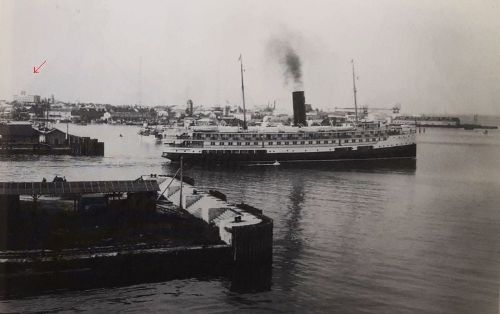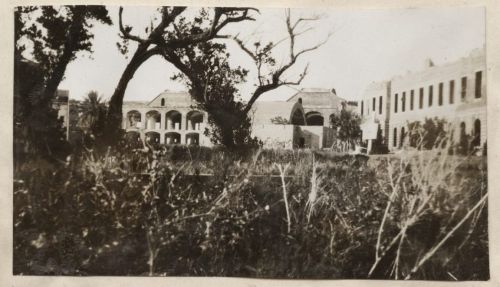“There it is!” John said, pointing excitedly out across the water. Rising seven stories tall, from an island along the horizon slowly growing more visible in size as we approached, was an unmistakable pinkish-white building. We were returning to Key West aboard the ferry Yankee Freedom III, which takes visitors 70 miles west of the island to a set of keys known as the Dry Tortugas, and just coming into our view was a sight Hemingway had seen nearly one hundred years earlier—the La Concha Hotel.

“I see it!” Sharon replied, equally excited.
In 1926, a developer named Carl Aubuchon opened what would be the first of its kind: a luxury hotel on Key West.1 Considered the epitome of elegance and modern convenience (with marble floors, private baths, an elevator, and stunning ocean views), the La Concha Hotel was at the time a jaw-dropping achievement, and was—just as it still is today—the tallest building on the island. Located at the corner of Duval and Fleming Streets, this “skyscraper” was the first glimpse and suggestion of an exotic downtown for travelers by ship toward the Caribbean island that is celebrated as the southernmost point in the contiguous United States;2 and it was exactly the sight that greeted Ernest and Pauline Hemingway as they sailed aboard a Peninsular & Occidental steamer from Havana, Cuba, into Key West Harbor, in April 1928.

Hemingway would later immortalize the way the hotel looms above the island, when he wrote: “Then we came to the edge of the stream and the water quit being blue and was light and greenish and inside I could see the stakes on the Eastern and the Western Dry Rocks and the wireless masts at Key West and the La Concha hotel up high out of all the low houses,” followed by, “Ahead now he could see the white of the La Concha hotel, the wireless masts, and houses of town.”3 Now, we too were seeing this building, from the water, as we sailed toward Key West Harbor.
Our day-trip aboard the Yankee Freedom III to the Dry Tortugas was specifically to visit Fort Jefferson—a pre-Civil War fortress (the largest masonry fort ever constructed in the United States, although never finished) located on Garden Key, near the very end of Monroe County, Florida.4 In May 1928, Ernest, Waldo Peirce, Bill Smith, Pauline Pfeiffer’s brother Paul, and Captain “Bra” Saunders camped out inside the fort during Hemingway’s first fishing trip to the Dry Tortugas. Hemingway would later return to the Dry Tortugas, and Fort Jefferson, on numerous fishing excursions.5


At around 20 miles west of Key West the Yankee Freedom III passes the uninhabited Marquesas Keys, another favorite fishing spot of Hemingway’s. Having missed catching a glimpse during the trip out to Fort Jefferson of this grouping of islands with its own lagoon, we stood sentinel on the return trip, giddy as the islands came into view off the boat’s port side.
“Look, the French Riviera,” John said with a smile, pointing out the strip of white, sandy beach, gleaming in the sun, clearly visible even from a distance. It was on one of these such beaches in the Marquesas Keys that, during their 1928 trip to the Dry Tortugas, Waldo Peirce took a photo of Hemingway, mugging for the camera and enjoying the sun, almost completely naked except for a strategically placed bit of fisherman’s gear. It’s known as The Socket Photo.
Sharon laughed, understanding John was poking a bit of fun at Hemingway’s acquaintance—and sometimes editor and collaborator—A. E. Hotchner. In his book The Good Life According to Hemingway, Hotchner identifies the beach where the Socket Photo was taken as being the famous stretch found in France, not Florida.6
On the return trip toward Key West we were thrilled to sight numerous seas turtles surfacing, and scores of flying fish sailing across the water. Having enjoyed the day boating, exploring Fort Jefferson, and baking in the sun, we treated ourselves to a dinner of locally-caught, fresh fish—the type of fish Hemingway himself would have caught and enjoyed at the Marquesas Keys and the Dry Tortugas. Afterward, for a further treat, we decided to pay a visit to a lovely art deco-styled bar we had spotted the night before while wandering Duval Street. A sign out front had promised the best mojitos in town, made with Papa’s Pilar Rum.
What we didn't know the previous night is that the bar is located inside the lobby of the La Concha Hotel, inside the very same building that had greeted Hemingway (and now us) on arrival to Key West from sea. Now, we were in for an up-close view of it all. It was time for more adventures, and supposedly the best mojitos around.

To be continued . . .
Works Cited
Hargrove, John. “The Saga of the Socket Photo, Part I.” THR Blog, The Hemingway Foundation and Society, 12/26/2022. https://www.hemingwaysociety.org/saga-socket-photo-part-i
---. “The Saga of the Socket Photo, Part II.” THR Blog, The Hemingway Foundation and Society, 01/05/2023. https://www.hemingwaysociety.org/saga-socket-photo-part-ii
1 In 1924, with plans on the table for the hotel’s construction, a $100 cash prize contest was held to give it a name. A man named Louis T. Braggasa, a recent transplant to Key West, who was working as a customs collector, took the island’s “Conch” identity for its native citizens and crafted “La Concha,” winning the prize. However, many Key Westers at the time abhorred the “Conch” moniker, and were rather offended.
2 This designation for an area continuously above water within the contiguous United States should actually go to Ballast Key, a privately owned island located nine miles west of Key West.
3 The first quotation comes from the short story “One Trip Across,” first published in Cosmopolitan (April 1934); the second comes from the short story “The Tradesman’s Return,” first published in Esquire (Feb 1936). Both of these short stories became Parts I and II of Hemingway’s Key West novel To Have and Have Not (1937), and are individually collected in The Complete Short Stories of Ernest Hemingway.
4 The last island in the chain is Loggerhead Key, located three miles west of Garden Key. Other keys have existed and disappeared over the years, including one key that Hemingway would have seen: Bird Key, located southwest of Garden Key. The site of numerous Union soldier graves during the Civil War, Bird Key disappeared from view in 1935.
5 Twice Hemingway and his fishing party were forced to camp out inside Fort Jefferson due to storms: March 1930, when the party that included Max Perkins sheltered inside the fort for nearly two weeks, and nearly ran out of food; and again in March 1932, when the party that included Archibald MacLeish spent three full days marooned inside the fort—which also saw Hemingway and MacLeish verbally spar—during eighteen days of stormy weather.
6 This was despite a landscape completely devoid of anything (including beachgoers) but sand and tropical island scrub.
Sharon Hamilton is a member of the Hemingway Society Board. She has blogged previously for the Hemingway Society about visiting Hemingway and Hadley’s Chicago Apartment and about Hemingway’s New Orleans.
John Hargrove is a Michigan-based writer and Hemingway researcher; he is also the founder of "Ernest Hemingway: The True Gen," an online community of Hemingway researchers and aficionados hosted on social media. He has blogged previously for the Hemingway Society about Hemingway's Socket Photo and Hemingway's High Carnival Next, a very early newspaper article.
Together, Hamilton and Hargrove have blogged about Hemingway in Buffalo, Wyoming; Pamplona, Spain; and Petoskey, Michigan. Their most recent post described their visit to Hemingway's Key West apartment.